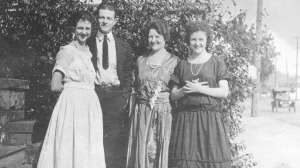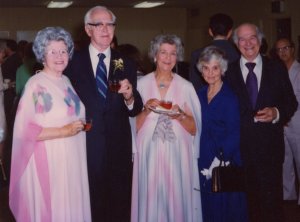Ava Helen Pauling’s childhood residence near Beavercreek, Oregon, now known as “The Miller House,” was built around 1907 and constructed so solidly that it still stands, albeit in a different location and with a different paint job than was originally the case. It has survived more than one-hundred years of weather and use, beginning with its housing of the Miller family, which included twelve children. Over subsequent generations the house was sold to at least two other families before being rescued in 2004 by Rick and Kassandra Young. Together with friends and family members, the Youngs have spent the last seven years engaged in the gargantuan task of renovating the Miller family home.
Before Ava Helen Pauling married Linus Pauling, she was Ava Helen Miller, a precocious child who grew up in Beavercreek, Canby and Salem, Oregon. Around the time of her parents’ divorce at age nine, the family’s big, beautiful two-story Craftsman style house was built, and Ava Helen lived on their 160-acre farm with her mother and siblings until the family moved to Canby for a time. When Ave Helen was thirteen, she moved away to Salem to attend high school and live with her older sister Blanche, who worked for the Oregon Supreme Court. As a result, Ava Helen did not spend a great deal of her childhood in the house that her family built, but the few years that she did spend there were sure to have been aesthetically pleasing, given the inviting nature of the house and its beautiful, forested surroundings.
When the Youngs bought the Miller House in 2004, it was not even habitable and had been condemned after standing empty for fifteen years. The couple purchased the home for one dollar. “I always wanted an old house,” said Kassandra, “but when we got this one everybody said I was crazy!” Crazy though it may have seemed, the Youngs’ one dollar purchase saved an important piece of history from being razed, though the couple did not know it at the time. Indeed, it wasn’t until after they had moved the house to a new parcel of land in 2005 that Rick began looking through the county’s historical records, in the process discovering that Ava Helen Miller had spent part of her childhood in their house.
Moving the Miller House two miles down the road was a challenging task which took eight hours, required the trimming of trees on both sides of the road to make way for the farmhouse, (which likewise entailed obtaining all of the neighbors’ permissions) blocked school bus routes for a little while and necessitated cutting off a few neighbors’ electricity for a short while. Now that it is moved, the house on the small hill looks as though it has always been there, accompanied by an old barn and ten acres of hay fields and trees. From the front porch, one is treated to a slightly elevated view of forested hills and a road winding between trees. To the north, one is sometimes able to see Mt. Hood. The view isn’t identical to that of the house’s original location, but is close enough that the Miller family probably peered out on something similar.
Restoring the house to habitable condition has been quite a journey for the Youngs, who started a blog about it in 2008 to record their progress. The blog, which can be found at http://www.1907millerhouse.com, also includes a photo of the structure as it was being built in the early 1900s, with members of the Miller family perched on a ladder reaching up to the top wraparound balcony. A copy of the photo now sits in a glass cabinet in the dining room of the house. In the photo the house has not yet been painted and looks gray. Especially in its unfinished form, one is able to see the sturdiness of the structure and the quality of the milled lumber. The Youngs used the original old photo as a guide to their restoration, and also procured copies of other photos from the Pauling Papers that they try to follow in their continuing renovations. They have also spoken with Linus Pauling Jr. and members of both the Pauling and Miller families about the house, and say that the Paulings have expressed a desire to hold a family reunion there in the future.
Today the house is in remarkably good shape given the fact that it is over 100 years old, has been uprooted and moved, and has been subject to generations of use by families with children. This solidity can be partly attributed to the tight, interlocking design of a Craftsman style house, and also to the precision and attention to detail that went into its construction. Kassandra notes that even in its condemned state there was virtually no rot in the frame of the house, and that it was built using 32-foot two-by-fours, while houses today are built using smaller, weaker beams. Features including a carved staircase and pocket doors, which slide into the wall to open, lend the house character.
The Youngs bought the Miller house in 2004, and worked on it for a year, living in a manufactured home behind the house, before moving in in 2005. “There was no electricity,” said Kassandra. “It was all gas lighting.” Rick and Kassandra did all the wiring and plumbing themselves, and installed lighting fixtures that look like lamps. “The plumbing was the hardest,” said Kassandra, though another big obstacle was getting cleared by Pacific Gas and Electric to move the house. They also had to refinance the house in 2009, which required them to speed up the renovation process and hurry to erect a railing on the lower deck and apply a layer of primer to the whole house. Refinancing was complicated, as were all the other obstacles in their way, but, Kassandra says, “I had to prove everybody wrong.” It may have seemed crazy to buy what appeared to be a pile of rubble, but she saw potential in the old house and appreciated the fine craftsmanship, even without knowing its history.
At this point, most rooms in the home are finished, including a spacious kitchen featuring salvaged yellow cabinetry and slate flooring that Kassandra installed. Leftover slate from the kitchen decorates the fireplace, giving the appearance of old brick. Although it has been thoroughly renovated to make it inhabitable, there is little that is new in the house. On the floor in the living room and parlor, old boards salvaged from another house have been installed, and the window in the kitchen is also a salvaged piece as well. Most of the windows, however, are the originals, with storm windows installed on some to make the drafty structure more airtight. The only aspect of the house that looks at all modern is the basement that the Youngs built; but Kassandra noted, “I want to eventually make that look old, too.”
The Young’s goal for this summer is to finish the porch and put up a railing around the top level. The porch was destroyed back in the 1970s when a tree fell on the house during a storm, so the Youngs are reconstructing it from scratch, making sure to follow the pattern depicted in their old photograph. Their biggest incentive for finishing the porch as quickly as possible, according to Kassandra, is that the Historic Registry requires them to restore it before they can submit an application for the Miller House to be added to the Registry list. The primary advantage to being placed on the Registry is a fifteen-year tax freeze on their property taxes, the only requirement being that they keep the house looking as it always has on the outside, and that they host an open house once per year.
Although the Historic Registry only requires that the outside of the house appear original, the Youngs have done an incredible job of keeping the inside period-appropriate. Every piece of furniture has been procured either from salvage yards like the Rebuild-it Center and Hippo Hardware, or from eBay or Craigslist. (In order to find the perfect pieces, Kassandra says she was “looking on Craigslist daily.”) The solid, carved 1890s mantelpiece in the living room was shipped from Georgia, and was a bright blue color when it arrived, lacquered with some twelve coats of paint that Kassandra painstakingly sanded off. Now only the grain of the wood is on display, complementing the rest of the house, which is replete with original wood paneling.
The Youngs have fully redone the inside of the house to both comply with the period look as well as to reflect their own tastes, but a few vestiges of the Miller family still remain in the space. The house will soon have the same outward appearance that it did when it was inhabited by the Millers (although now it is a greenish blue color trimmed with a deep wine) and a few photos of the Millers reside in the home. Before they moved the structure, the Youngs also found and saved a stepping stone with the names Betty, Lulu and Jack engraved on it: Lulu and Jack were two of Ava Helen’s siblings, Betty was probably a cousin. A few streets in the area are also named after members of the Miller family and Ava Helen’s grandmother is buried in a cemetery up the road. The structure is in a new location with a new coat of paint and a new family living in it, but the Youngs are determined to retain the authenticity of the Miller House, and to keep the memory of the Millers alive.
Filed under: Ava Helen Pauling, Just for fun | Tagged: Ava Helen Pauling, Beavercreek, historic homes, home restoration, Miller family, Oregon | 1 Comment »


































 With this boom in military-minded production, underpaid laborers saw opportunity. In early September, wooden shipbuilders up and down the coast of Oregon began plotting a walkout. They knew that, with the need for ships and at an all-time high, plant management would be forced to meet their demands in order to get production back on schedule. Unfortunately for the would-be strikers, word of the plan got out. On September 14, the day before the walkout, E. W. Wright, manager of McEachern Shipbuilding in Astoria, closed his plant for the weekend, effectively superseding the workers’ strike.
With this boom in military-minded production, underpaid laborers saw opportunity. In early September, wooden shipbuilders up and down the coast of Oregon began plotting a walkout. They knew that, with the need for ships and at an all-time high, plant management would be forced to meet their demands in order to get production back on schedule. Unfortunately for the would-be strikers, word of the plan got out. On September 14, the day before the walkout, E. W. Wright, manager of McEachern Shipbuilding in Astoria, closed his plant for the weekend, effectively superseding the workers’ strike.













